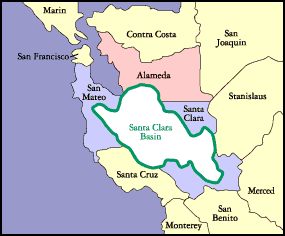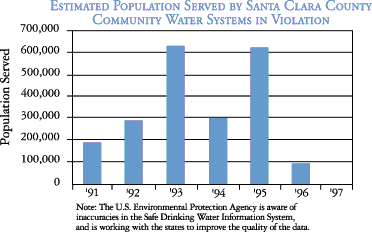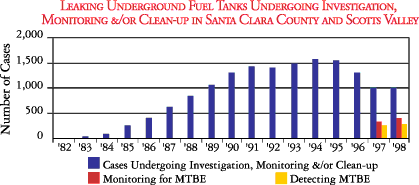
Map Source: Santa Clara Basin
Watershed Management Initiative
Watershed Health In Serious Condition
Why Is This Important?
A watershed is an area of land from which all water
drains to a common water body, such as a bay, lake, or
river. The health of streams and other water bodies
reflects conditions throughout its watershed.
Many human activities affect the quality of watersheds, including residential and commercial development, road construction, agriculture, grazing, and recreation. Without careful planning, these practices can harm water quality by contributing sediment from erosion and by releasing contaminants such as household chemicals, oil and debris from roads, and fertilizer and pesticide runoff.

Map Source: Santa Clara Basin
Watershed Management Initiative
There are 14 major watersheds in the Santa Clara Basin. The Santa Clara Basin covers about 850 square miles and is approximately 56% the size of Silicon Valley.

How Are We Doing?
The U.S. Environmental Protection Agency has developed an overall score for the Santa Clara Basin by evaluating 14 different indicators of its watersheds' condition and vulnerability. Based on this evaluation, the Santa Clara Basin is assigned a 5 on a scale of 1 (best) to 6 (worst), reflecting serious condition.

In particular, the Santa Clara Basin has relatively serious problems with attaining beneficial uses (i.e., drinkable, fishable, swimmable), high contaminant levels in fish such as mercury (prompting consumption advisories), serious impairment of our drinking water sources (before treatment and purification), and loss of wetlands.

Data Source: U.S. Environmental Protection Agency,
Index of Watershed Indicators
While the Santa Clara Basin has relatively lower vulnerability to future declines in aquatic health, three areas of concern include a high number of aquatic species at risk, high potential for urban runoff, and rapid population growth.
Why Is This Important?
More than half of Santa Clara County's drinking water is imported. Roughly 40 percent comes from local groundwater. Imported water is disinfected and filtered before it is distributed. Groundwater is usually not treated
since it is naturally cleansed of most substances
as it moves down through the soil, though it is sometimes disinfected to provide additional protection from biological contaminants. Both water sources are thoroughly tested before delivery to customers.
How Are We Doing?
The percentage of analyses in compliance with drinking water standards has been greater than 99 percent since 1994. Less than one percent of analyses exceed drinking
water standards - the equivalent of 47 to 110 exceedances
per year.
From 1991 to 1997, the estimated population served by Santa Clara County Community Water Systems in violation of health-based standards has ranged from a high of more than 625,000 in 1993 to a low of 1,120 in 1997. It is important to note that the U.S. Environmental Protection Agency (EPA) is aware of inaccuracies in the Safe Drinking Water Information System, the database from which this information is derived. The EPA is working with the states to improve the quality of the data. Moreover, health-based violations do not necessarily indicate an immediate cause for concern, since most contaminants are only a concern for adults if ingested at levels higher than the maximum contaminant level over a lifetime. Further, any drinking water source that exceeds the maximum contaminant level is taken out of service.
Small amounts of MTBE have recently been detected in Santa Clara County's drinking water, though at levels which are below California's drinking water standards.
These indicators measure drinking water delivered to customers after treatment and testing. They do not measure the quality of groundwater or other drinking water sources before treatment and testing. For example, industrial solvents have been detected annually in 0.7% to 2.1% of groundwater samples taken between 1989 and 1999.
Why Is This Important?
In recent years, leaking underground tanks and industrial spills have threatened groundwater
quality in some areas of the county. Motor fuel
and other hazardous chemicals are discharged from leaks
and spills. Motor fuel has contained methyl tertiary butyl ether (MTBE) on a statewide, year-round basis since 1996, when it was introduced to California's gasoline to meet federal smog regulations. Although the human health effects of MTBE are not fully understood, the U.S. Environmental Protection Agency classifies it as a possible human carcinogen (i.e., cancer-causing). If left unchecked, contaminants from leaks and spills could seep down into deep aquifers and become a major water quality problem.
How Are We Doing?
Policy makers recently announced a plan to remove MTBE from California's gasoline by the end of year 2002. One lesson learned is the importance of taking a precautionary approach and considering how policy decisions will affect a variety of media, including air, water, and land. A 1998 study by the University of California estimated it would cost $36 million to clean California's drinking water wells that were shut down due to MTBE contamination. Cleaning up all groundwater could cost $1.5 billion.
In addition to the approximately 966 fuel leak cases undergoing investigation, monitoring, and/or clean-up during 1998 in Santa Clara County and Scotts Valley, 245 sites with hazardous chemical leaks are undergoing clean-up in Silicon Valley. Hazardous chemical leaks, which are largely comprised of solvents, pose a greater threat to groundwater than do motor fuel leaks because solvents are highly soluble (capable of being dissolved), mobile, and long-lasting.
Website developed by Clary Meuser Research Associates
![]()
Drinking Water Meets or Exceeds Standards;
Protection From Contaminants Is Critical
Healthy, safe supplies of drinking water are critical to human survival and well-being. Waterborne diseases can become epidemic in communities with contaminated water supplies. Contaminated water may also lead to birth defects, infant mortality, increased cancer rates, and other systemic ailments. Federal and state safe drinking water laws aim to assure the high quality of public water supplies.

Data Source: California Department of Health Services
Extensive laboratory analysis conducted by water utilities serving Santa Clara County confirms that drinking water delivered to customers generally meets or surpasses all state and federal standards for health, safety, and aesthetics. Most substances for which drinking water standards have been set or proposed are not found in Santa Clara County's drinking water supplies, or they are detected at levels which are far below the standards.

Data Source: Safe Drinking Water Information System,
Center for Environmental Information and Statistics,
U.S. Environmental Protection Agency
![]()
Fuel Leak Cases Drop, But MTBE Shows Up in Water Sources
Roughly 40 percent of Santa Clara County's drinking water comes from groundwater. The County's groundwater has traditionally been of very high quality and was once considered relatively safe from pollution. Although soil filters out bacteria and most other pollutants, it cannot filter out everything. Chemicals may seep down into the groundwater from numerous sources including leaking underground storage tanks, illegal dumping, surface spills, landfills, septic systems, and improperly constructed and maintained wells. Once an aquifer becomes polluted, cleanup is difficult and very expensive.

Data Sources: San Francisco & Central Coast Regional Water
Quality Control Boards, Santa Clara Valley Water District
The number of motor fuel leak sites in Santa Clara County and Scotts Valley discovered and undergoing investigation, monitoring, and/or clean-up peaked at 1,557 in 1994 and has since decreased by 38% to 966 in 1998. This achievement is due to clean-ups, retrofits, upgrades, and case closures triggered by federal and state underground storage tank regulations enacted about 10 years ago. Motor fuel contamination from leaking tanks has been largely confined to the shallow groundwater aquifers which are not used for drinking water. However, about 71% of the fuel leak sites that monitored for MTBE in 1998 detected it, and small amounts of MTBE have been detected in Santa Clara County's drinking water supplies, including groundwater and local reservoirs. The detection levels of MTBE in Santa Clara County's drinking water are below California's drinking water standards.
Copyright � 1999, Silicon Valley Environmental Partnership
All Rights Reserved